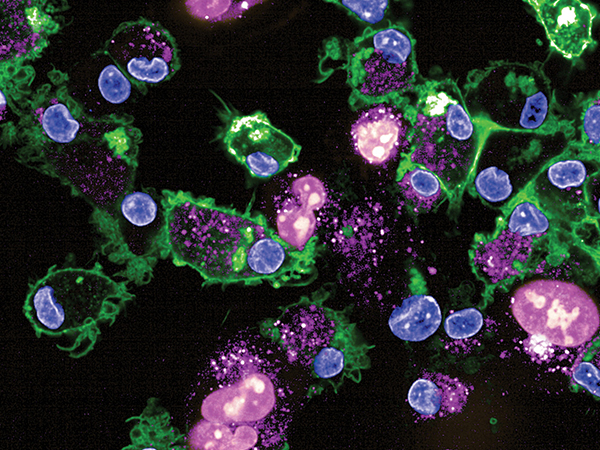Imaging and New Technologies in Immunotherapy
The advent of immunotherapy has led to durable responses for an increasing number of patients, including many who initially faced a poor prognosis. Unfortunately, those who respond to immunotherapy remain in the minority. Therefore, finding new ways to identify and stratify patients who are the most likely to respond to specific immunotherapeutic approaches is a major focus in the field.
Imaging a patient’s cancer—and the responses generated by the immune system—can provide key information that may guide immunotherapeutic treatment decisions throughout therapy. Advances in the imaging arena, such as the real-time, noninvasive visualization of specific cells, or the application of artificial intelligence (AI) to pathology, have garnered recent attention in the immunotherapy space.
Using immuno-PET to characterize T-cell responses to checkpoint inhibition
The topic of imaging was the focus of a plenary session at the Tumor Immunology and Immunotherapy special conference, held recently in Boston. Imaging immune responses can provide information about how specific T-cell subsets are responding to tumors or to therapeutic strategies, but such studies require a biopsy, which is often invasive. Positron emission tomography (PET) offers an attractive alternative for imaging the immune response, noted Mohammad Rashidian, PhD, from Harvard Medical School, in the first talk of this plenary session.
A traditional PET scan is a whole-body imaging technique that uses the radiotracer 18F-fluorodeoxyglucose (FDG) to visualize multiple metabolically active tumors at once. Immuno-PET, on the other hand, uses radiolabeled antibodies to target cell surface markers to detect specific cells. Conventional antibodies are large, resulting in low tissue penetration and require several days to clear through the circulatory system, Rashidian noted. His team used “nanobodies,” or single-domain antibodies that include a variable domain derived from heavy-chain-only antibodies, for immuno-PET.
Using anti-CD8 nanobodies, Rashidian and colleagues could visualize CD8-positive T cells to better understand the trafficking of the immune response into the tumor microenvironment. They utilized this approach in tumor-bearing mice treated with checkpoint inhibitors and found that mice that responded to treatment had infiltration of CD8-positive T cells throughout the tumor core.
Because immuno-PET can actively monitor immune response, this technique could be used to help predict which patients will respond to immunotherapeutic regimens.
Implementing PD-1 and PD-L1 PET in human patients
The second talk, delivered by David Leung, MD, PhD, from Bristol-Myers Squibb, focused on the application of immuno-PET imaging in the clinical setting—specifically, first-in-human experiences of PD-1 and PD-L1 PET.
Leung showed data from two patients with non-small cell lung cancer (NSCLC) classified as PD-L1-positive and PD-L1-negative, respectively. First, using PD-L1 PET, Leung and colleagues found that PD-L1 expression by PET correlated with immunohistochemistry results. The researchers found that the patient who did not respond to checkpoint blockade was determined as having low PD-L1 expression by PET, indicating a prognostic utility for PD-L1 PET.
Both PD-L1 PET and conventional FDG PET were performed on the PD-L1-positive patient. PD-L1 PET showed the infiltration of PD-L1 into the tumor as heterogeneous, which was in contrast to the images seen with FDG PET, highlighting the ability of PD-L1 PET to capture the differential expression of PD-L1 throughout the tumor.
Next, Leung and colleagues used radiolabeled nivolumab to analyze PD-1 expression via PET. As expected, the radiolabeled nivolumab accumulated in the PD-L1-positive tumor, but not the PD-L1-negative one.
The goal of this work is not to replace biopsies, stressed Leung. However, a noninvasive method to evaluate multiple tumors simultaneously, rather than an invasive method that generates a single sample of a single tumor, could provide key additional information, he added.
Leung concluded by noting that data from PET can be integrated with other imaging modalities and with other parameters such as demographics, genomics, and biomarkers to help improve outcomes.
Applying AI to revolutionize pathology
While there are numerous benefits to alternative imaging modalities, the definitive diagnoses for many diseases, including cancer, require analysis of tissue samples, noted Andrew Beck, MD, PhD, from the imaging company PathAI. Pathology images hold enormous amounts of valuable information—yet the evaluation and interpretation of these images by humans has limitations, Beck said. He referenced prior studies that illustrate discordance among pathologists’ reports when analyzing breast and skin biopsies, and said that AI could be used to transform pathology.
Data generated by Beck and others have shown that AI has the power to outperform human pathologists. To further improve this approach, Beck and colleagues are working to implement data annotated from millions of samples by hundreds of pathologists to incorporate more patterns into the deep-learning model. With such large datasets come real-world challenges, such as differences in slide quality. Beck and others are working to build specific deep-learning models to overcome these challenges.
PD-L1 has become an important biomarker for some therapeutic treatments that utilize checkpoint inhibitors, yet robust pathological platforms to accurately measure this biomarker are lacking, noted Beck. A major focus of Beck and others is to use AI to accurately distinguish PD-L1 expression on specific immune cells and tumor cells. This information can be used to better identify patients who will respond to immune checkpoint blockade.
Irreversible electroporation: playing with H-FIRE
The final presentation of the session was a short talk delivered by Irving Allen, PhD, from Virginia Tech, who focused on tumor ablation techniques – specifically, high frequency irreversible electroporation (H-FIRE), which utilizes electrodes to induce permanent holes in cellular membranes which leads to cell lysis. To better understand how this tumor ablation technique works mechanistically, Allen highlighted data from preclinical mouse models treated with H-FIRE. In addition to local and metastatic tumor control, Allen and colleagues found that H-FIRE reduced the populations of immunosuppressive cells, activated signaling pathways related to damage-associated molecular patterns, and increased the levels of pro-inflammatory cytokines, suggesting that this type of tumor ablation is immunomodulatory. Allen noted that future work will determine whether H-FIRE is affecting the adaptive immune system.




